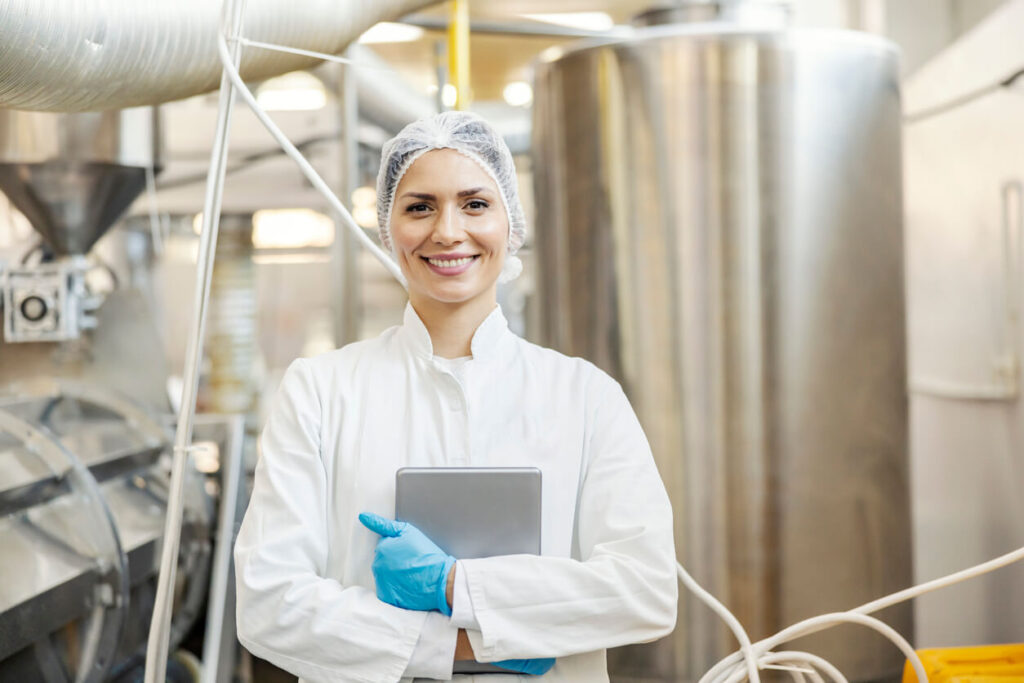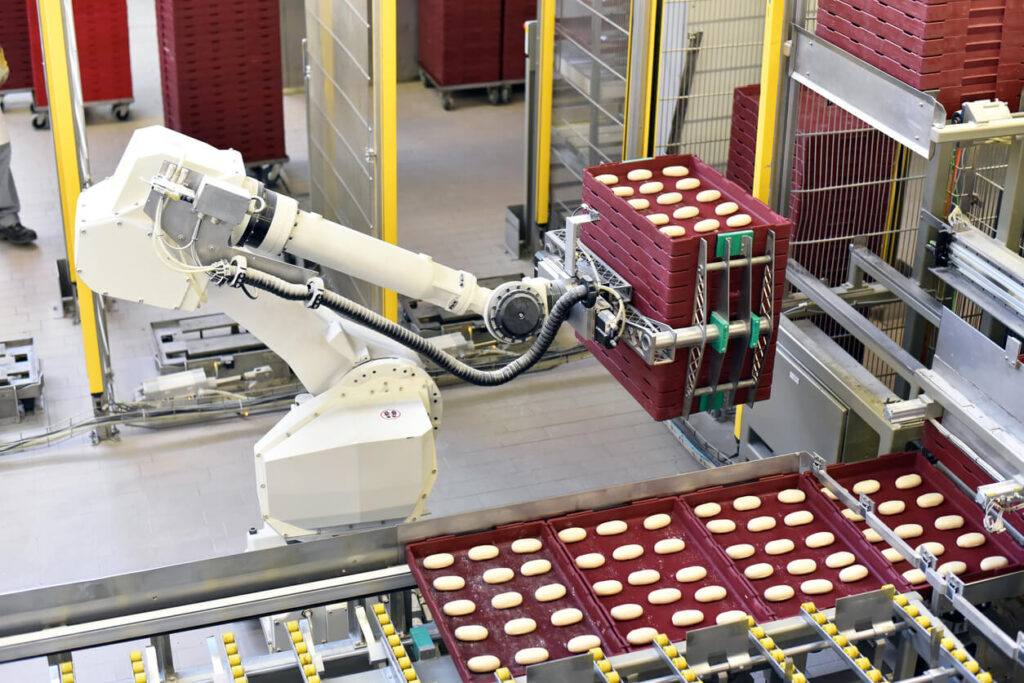Food and beverages are essential to our everyday lives. The production of these products is becoming increasingly automated, thanks to the implementation of advanced solutions, like robots, digitalisation, and machine learning.
Manufacturers and factory owners are constantly seeking ways to increase production and efficiency in their facilities. Many of them are turning to robotic solutions, changing their processes into smart factories, enhanced with automation, artificial intelligence (AI) and machine learning. Automation has become an essential part of the production line, redefining how we approach food production and distribution.
In this article you will find out how automation technologies are changing production processes and establishing new benchmarks for precision, safety, and creativity in the food and beverage industry.
Introduction to Automation in the Food and Beverage Industry
The food and beverage industry is one of the most prominent industries globally, with an estimated value of 7,221.73 USD billion in 2023 and is expected to grow annually at a CAGR of 6.3%. The industry is made up of a wide range of companies that produce and distribute food, from global food processing giants to small-scale local businesses. It plays a vital role in the global economy, not only as a supplier of food for the masses, but also as an important employer and a generator of wealth and income. Unfortunately, it is also one of the most environmentally polluting industries in the world, responsible for a significant amount of waste and greenhouse gas emissions.

Therefore, to reduce the environmental impact and improve productivity and efficiency of the industry, the manufacturing sector needs to adopt automation solutions. Automation is an essential part of today’s food production and distribution processes. From automated food processing lines to intelligent automation solutions, manufacturers are using automation technologies to improve their production, efficiency, and profitability, and to reduce their carbon footprint.
Automation shows considerable promise for reducing the impact of farming on climate change and helping growers adapt to its financial impact.
Rob Bland, Vasanth Ganesan, Evania Hong, Julia Kalanik, May 31, 2023, McKinsey, Trends driving automation on the farm
Benefits of Automation in Food and Beverage
It all began with simple mechanisations for tasks like packaging and sorting, and has now grown to include complex robotic systems, artificial intelligence, and the Internet of Things (IoT). Automation is changing and as a main part of Industry 4.0, it is even more prominent in the fifth industrial revolution. Automation is a sign of technical progress in the industry.
Robotic assembly lines that guarantee consistent product quality and complex software systems that track production and manage inventory are all examples of automation technologies. Automation plays a key role in the food and beverage industry, helping with many aspects of production, processing, and distribution. Have a look at all the advantages that automation offers the industry:

- Enhanced Efficiency – automation expedites production procedures, resulting in a greater yield in a shorter amount of time.
- Consistent Quality – by eliminating errors and variability, automated systems guarantee consistency in product quality.
- Cost Savings – automation has the potential to drastically lower operating and labour costs over time.
- Enhanced Safety – automation lowers workplace accidents and enhances food safety and hygiene by managing risky tasks.
- Reduced Waste – less material waste results from improved process control and production precision.
- Scalability – production can be more easily scaled to meet variations in demand thanks to automation.
- Data-Driven Insights – data produced by automated systems can be utilised to improve operations and make decisions.
- Flexibility – in response to changes in the market, automated systems of today can be swiftly modified for a variety of products or packaging.
- Sustainability – by maximising resource utilisation and cutting waste, automation can help promote more environmentally friendly practices.
- Labour Reallocation – automation frees up human labour for higher-skilled jobs, increasing output and job satisfaction in general.
Types of Automation Technologies
Every technology has a distinct function in improving the production process, from the accuracy of robotic arms to the data-driven insights of artificial intelligence and the networked capabilities of the IoT.
Have a look at how these developments not only simplify processes but also create new opportunities for efficiency, quality assurance, and flexibility in response to shifting consumer demands.
Robotics
Robots are already widely used in the manufacturing industry, from robotic arms in factories to autonomous and automated guided vehicles (AGVs) and drones. They are also becoming utilities in the food and beverage industry. In general, robots can work in a wide range of environments and are able to handle a variety of tasks, from welding to picking and packing, to more complex processes such as machine vision and inspection.
Robotic Arms: In operations like product assembly, sorting, and packaging, these have become indispensable. Robotic arms can handle delicate objects like fresh produce or elaborate confectioneries without damage because of their superior speed and precision compared to human capabilities. They are also used for jobs that need a lot of consistency, like portion control and food decoration.
Currently, the xARM robotic arm is available to backorder from Distrelec, click here to view the product page.
Automated Guided Vehicles (AGVs): Material handling is a large application for AGVs. With as little human involvement as possible, they move supplies, completed goods, and raw materials across a factory. In addition to boosting productivity and lowering the possibility of mishaps or product damage, AGVs are designed to navigate through the manufacturing facility.
Drones: Drones are starting to be utilised for internal logistics and monitoring in larger food manufacturing facilities. They are employed in huge warehouses to track inventory and help with stock management since they can transfer small products or samples quickly from one area of a facility to another.
These robotic systems rely heavily on a reliable and effective wire infrastructure. This is demonstrated by Amphenol LTW‘s M8 and M12 connectors, which provide significant time savings for wiring system installation and maintenance. In the food and beverage processing industries, these connectors are particularly helpful as they facilitate the application of specialised professional abilities, guaranteeing the dependable and effective functioning of robotic or any other industrial automation equipment in challenging production situations.
AI and Machine Learning
Artificial intelligence is becoming a commonplace feature in the food and beverage industry. From warehouse management to product development, AI can be used in a wide range of processes. Enhanced with machine learning, AI can help to create safer food products and streamline the production process.
Quality Control: AI algorithms are trained to recognise flaws or variations in food items. These algorithms may identify problems that are invisible to the human eye through the use of visual inspection systems, guaranteeing that consumers only receive products that are of the greatest calibre.

Predictive Maintenance: With AI, equipment faults can be predicted before they happen. AI can uncover trends that point to possible breakdowns by analysing data from sensors and machinery. This enables preventive maintenance and minimises downtime. Find out more in this article on how AI and IoT solutions, such as different types of sensors, including proximity or capacitive sensors, are used in the agriculture industry to monitor and analyse soil quality and levels of seeds.
Optimisation: Automation in the food industry doesn’t mean only the improvement of food manufacturing processes; machine learning algorithms are utilised to optimise recipes by analysing a wide range of data, such as ingredient interactions, consumer preferences, and processing conditions. Because of this, recipes can be easily modified to reflect shifting consumer preferences or ingredient availability, all while maintaining a constant taste and texture.
Internet of Things (IoT)
Internet of Things and Industrial Internet of Things (IIoT) are terms used to describe the interconnection of physical devices (things) that contain embedded technology to communicate and sense or interact with their internal states or the external environment. IIoT is an extension of IoT specifically related to industrial automation. In the food and beverages sector, the use of IoT is growing rapidly.
Real-time Monitoring: In order to monitor several characteristics such as temperature, humidity, and equipment performance, IoT devices are implanted throughout the production process. The manufacturing environment must be kept within ideal bounds, which directly affects product quality, and this real-time data is essential for that purpose.
In Distrelec, you can find products that measure temperature, humidity and can be used in food industry applications. One of the products that we offer is the humidity and temperature probe from E+E Elektronik, built for demanding OEM applications. It monitors temperature and humidity as well as physical characteristics including mixing ratio, dew point temperature, and absolute humidity.
Other devices are the resistance thermometers from Endress + Hauser, particularly intended for use in sanitary and aseptic applications in the Food & Beverages and Life Sciences industries. In terms of sensors, discover the temperature sensors with IO-link from Jumo, commonly used for temperature and measurement and monitoring in the process automation and food and beverage industry.
Control of Production Parameters: Automation and remote control of production processes are made possible by IoT technology. To ensure a smooth and effective production process, for example, modifications in cooking temperatures, conveyor speeds, or packing equipment can be performed automatically in response to data received from IoT sensors.
Festo offers smart products suitable for the food and beverage industry, including decentralised valve terminals used in highly efficient beverage bottling and packaging lines or automated baking systems.
Supply Chain Management: An important factor in supply chain optimisation is the use of IoT devices. They enable better inventory management, waste reduction, and improved supply chain responsiveness by offering real-time tracking of both raw materials and completed goods.
Some of the edge connectivity products for IoT solutions include industrial cellular routers from Teltonika, very useful in advanced industrial applications, including remote equipment monitoring and management. Another example are the interface gateways from Moxa, suitable for industrial applications such as factory automation and other process automation industries.
Last but not least, there are the serial device servers from Brainboxes, designed to monitor outputs from the machine, for example to calculate the food waste volume. A large selection of items from Brainboxes might help with your automation and control applications, such as food processing and packaging.
Quality Control in the Food Industry
In order to make sure that final products and production processes adhere to safety and quality standards, quality checks in the food industry entail examining raw materials. This involves conducting safety tests in laboratories, assessing consistency and taste through sensory evaluations, and making sure that regulatory requirements are met.
In order to track products and effectively handle any problems, traceability systems are also necessary. Ensuring food safety and quality to the highest standards and fulfilling legal and consumer requirements are all dependent on these actions.
To find out more about food safety in the EU, read the following documents:
To see the quality control rules in different regions, refer to the specific countries’ regulations.
Automation Solutions in Food and Beverage Manufacturing
The future of the food and beverage industry strongly relies on automation. The use of automated solutions in the production of food and drink marks the beginning of a new era in productivity, excellence, and innovation. The advantages of automation go much beyond higher output and lower costs, as we have shown. They include increased product consistency, better safety and hygiene, production flexibility, and the capacity to quickly adjust to shifting customer preferences.
Some of the obstacles on the path to automation are the upfront costs and the requirement for a workforce with the necessary skills to operate these technologies. The benefits of adopting these technological advancements over the long run, however, are clear: operational efficiency, sustainability, and maintaining competitiveness in a market that is changing quickly.
Distrelec is a distributor of automation products and automation components suitable for a wide range of applications, including the food and beverage sector. If you haven’t found the right one yet, discover a broad selection of products by clicking the button below.










